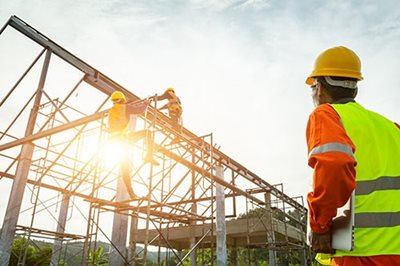Are temporary works in construction a permanent health & safety risk? Info Exchange investigates and reveals ways to stay safe.
When you consider that over 70% of sites accidents, including a shocking 20 fatalities, reported to the HSE in 2018/19, were related to temporary works, it should raise some concerns. Add to that the fact that 35% of the costs on any building project are associated with temporary works, and I think you’ll agree that this ‘poor relation’ of the construction industry probably deserves more attention.
What are temporary works in construction?
Temporary works are an engineered solution used to support or protect existing structures or permanent works during construction. Examples of temporary works in construction include earthworks, such as trenches, excavations and temporary slopes; or structures, like formwork, falsework, types of cofferdam and cofferdam installations, scaffolding and temporary bridges.
The construction of most types of permanent works will require the use of some form of temporary works: but this critical activity is often perceived as the poor relation.
In most cases, they are removed after use, and there is no trace of its presence in the completed project. Perhaps there is a tendency to pay less attention to temporary works design and management on many sites, due to this transient nature. But, as the numbers quoted above clearly indicate, when poorly managed, temporary works can be costly: both financially and as a health and safety hazard.
Case Study: St Modwen Homes and EcoOnline
St. Modwen Homes is a multi-award-winning UK housebuilding business, recognised for its extensive portfolio of design-led, high-quality homes. It has won industry recognition for its house design, customer care and outstanding commitment to regeneration and remediation of brownfield land and urban environments.
St Modwen’s partnership with Info Exchange began when the company was searching for a technology platform to manage the increasing number of accidents and incidents across its sites. The result was a bespoke solution built around St Modwen’s specific requirements. And because the Info Exchange system, is so highly configurable it was soon recognised that it could be used to manage other areas of their business.
Dave Smith, Managing Director, St.Modwen Homes, explains, ‘we conducted an audit of our business and discovered that temporary works were a big risk. We have recruited regional temporary works controllers and have been using a paper-based system to manage the temporary works across 30 to 40 sites. The process has been time-consuming and labour intensive and in need of continuous site visits across the country for the purpose of audit and inspection.
Having the system already in place for accidents and incidents we identified that the set-up, capabilities and workflows that we created with Info Exchange could be easily re-configured for temporary works.’

An industry-first within the house building industry, St Modwen are now in the process of digitising the management of their temporary works. Dave Smith tells us how. ‘We will be working with Info Exchange to develop a platform that will work across the three areas of temporary works management. These include maintaining temporary works contractors to provide visibility at a group level of those who are approved and in contract, on temporary works design of structures and earthworks, and for inspections and audits across our multiple sites.’
By using Info Exchange, St Modwen Homes have ensured that they are health and safety compliant, quality assured and approved; and consistently using contractors with the right qualifications and experience for the job.
Leon Jennings, Group H&S Systems Manager, ‘We are very excited to be working with Info Exchange and to be leading the way digitally within the house building industry.’
Info Exchange = effective management and reduced risk within temporary works
Our work with companies like St. Modwen Homes has shown us the critical importance of proactive temporary works management in construction. Here are some of the key benefits of using a digitised solution with Info Exchange:
- Providing businesses with real-time information for reporting incidents to HSE
- Facilitating QR code scanning to reduce the risk of checks not being completed within the required timescales
- Enabling companies to effectively track their assets, audits and inspections (by job) across multiple sites
- Allowing highly configurable, bespoke functionality and workflow solutions to be developed in line with a company’s specific requirements
- Ensuring an accurate and up-to-date temporary works register is always maintained
Info Exchange promotes efficiency, quality and productivity of temporary works on construction sites, while significantly increasing health and safety standards. Its process-led solutions ensure works happen at the right time, in the right location and is completed by the right contractor.